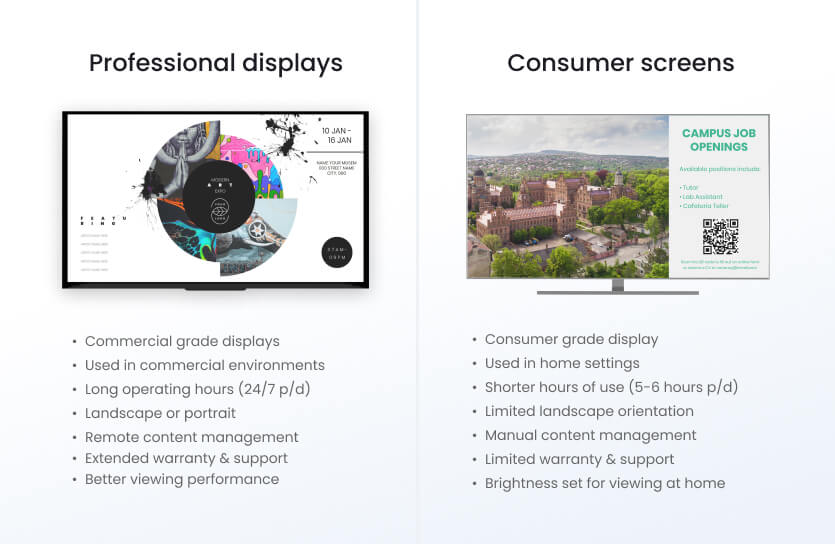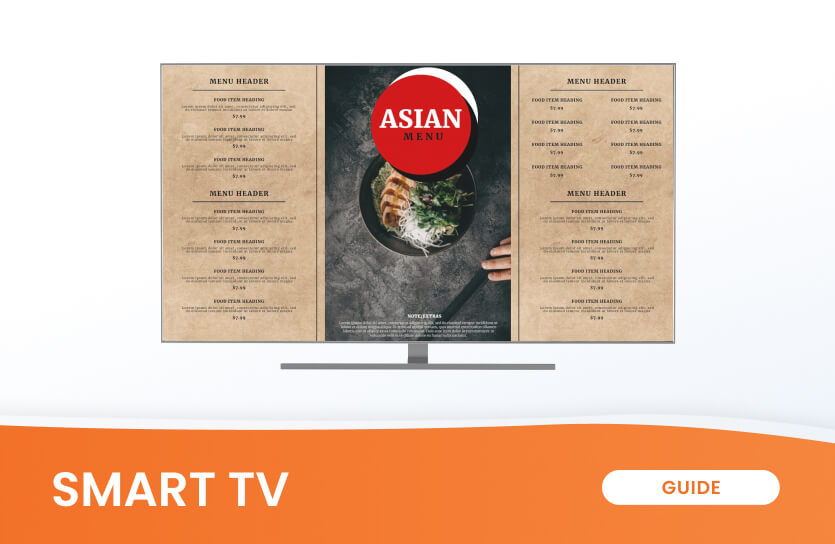Digital signage is around us everywhere we go. From offices and airports to restaurants and retail stores, digital displays are offering more and more industries new ways of engaging customers and employees.
It’s time for your business to adopt digital signage, but what is there to know? Whether you’re going to create digital advertising screens or a digital announcement board, start yourself off right by getting the lowdown on digital signage software for smart TVs. Plus the need-to-know steps to turn a TV into digital signage.
What is digital signage software for smart TVs
However you intend to interact with your audience or get your message across, you’ll need a screen to display your content and a digital signage player to turn your TV into a signage screen. Digital signage software is a tool that provides a content management system (CMS) for creating, scheduling and deploying whatever you want to display on screens.
To operate digital signage, a screen is always required. Digital signage media players are hardware devices connected to screens and the internet. Alternatively, a hardware-free solution for a media player is a web player. For this type of solution, there is almost no setup involved – only a display device that has a Chrome/Edge browser.
Difference between smart TV and digital signage screens
What is the difference between TV and digital signage? If you’re new to digital signage, you’ll have to consider whether to use custom screens for digital signage or consumer TVs. Basically, digital signage screens and TVs have different purposes. However, both be used as digital signage solutions. So, what’s the difference?

How do I use my smart TV as digital signage?
Smart TVs make it easy for you to connect to the internet and integrate with many apps and other smart devices. But, you might be wondering how you can use your smart TV as digital signage, and what resources you need to set it up.
TV (size, location, orientation)
Depending on your use case and the type of content you want to display, we recommend choosing a screen that is between 32 inches – 64 inches. Additionally, you’ll also have to decide where the screens will go. Think high traffic areas, screens mounted at eye level, or an accessible position for interactive content.
TV mount
Wherever you want to strategically place your digital displays, you’ll need a mount to hold the screen in place. Digital signage mounting solutions range from display stands and digital menu board mounts to wall mounts and display carts. Keep in mind, TVs can be mounted horizontally or vertically to suit the content you are displaying.
Wifi
Digital signage connectivity requires a wifi connection. With slow internet, it may take more time for the player to download content. Or you may experience interference issues on screen. Meanwhile, if you have an internet outage, you won’t be able to change content remotely. So, speeding up your internet can solve any wifi woes and the performance of your digital signage solution. Conveniently, some solutions keep displaying content, even if there’s no internet connection.
Digital signage player (provider)
To show anything on a screen, you need a digital signage player to build and manage content displays. These devices connect to your TV screen and pair with software that retrieves content to play back on the screens. Worried about setting up the hardware? Don’t be. Cloud-based digital signage is a plug-and-play solution that can be set up in minutes.
Screen displays
After syncing your screen with a digital signage solution, it’s time for content creation! Get engaging screen designs in just a few clicks with resources like free templates, stock images and videos or apps. The best part? Media rich digital signage platforms are set-up to make it super simple for non-designers to create quality content.
10 best digital signage software features
There are certain features to look for in digital signage software to make sure you are investing in the best possible solution.
- Reliability
- Multimedia formats
- Security
- Scheduling
- Free Layouts
- Free Apps & images
- Remote monitoring and control
- Multi-user access
- Unlimited storage
- Customer support
Starting to get the picture? Try a provider that offers a trial option or a free version to ensure you get the features and functionality that are right for you.
